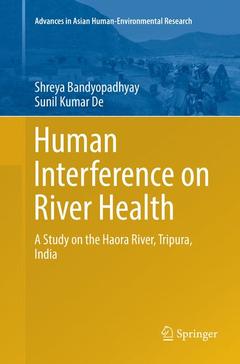Description
Human Interference on River Health, Softcover reprint of the original 1st ed. 2017
A Study on the Haora River, Tripura, India
Advances in Asian Human-Environmental Research Series
Language: English
Subjects for Human Interference on River Health:
Publication date: 06-2018
Support: Print on demand
Publication date: 11-2016
Support: Print on demand
Description
/li>Contents
/li>Comment
/li>
Introduction.- Geographical Setting of the Study Area.- Materials and Methods.- Status of Population Growth.- Changing Course of the River Haora.- Impact of Industrialization and Agriculture on the Haora River.- Impact of Slums and Rural Clusters on the Haora River.- Soil Loss and Sediment Yield of the Haora River Basin.- Estimation of Bank Erosion of the Haora River and Proposition of Bank Erosion Vulnerbility Zonation Method.- Spatio-Temporal Changes in Pollution Status of the Haora River.- Recommendation and Conclusion.




